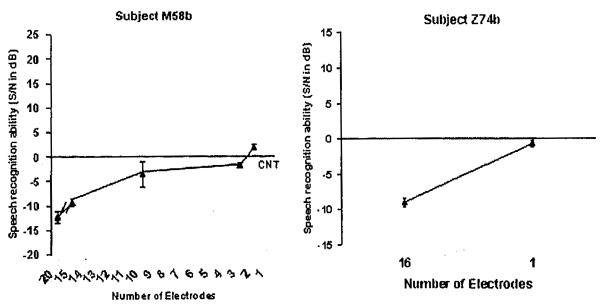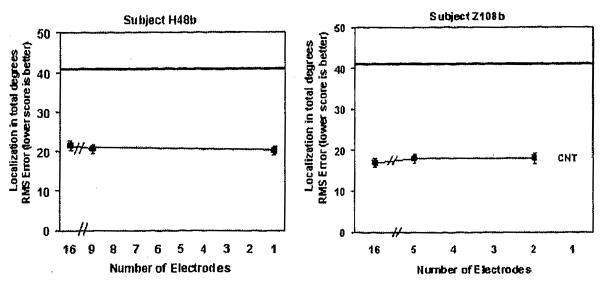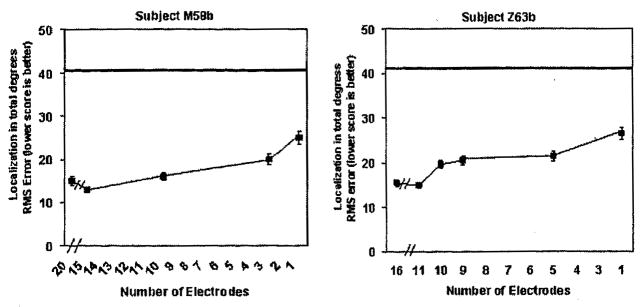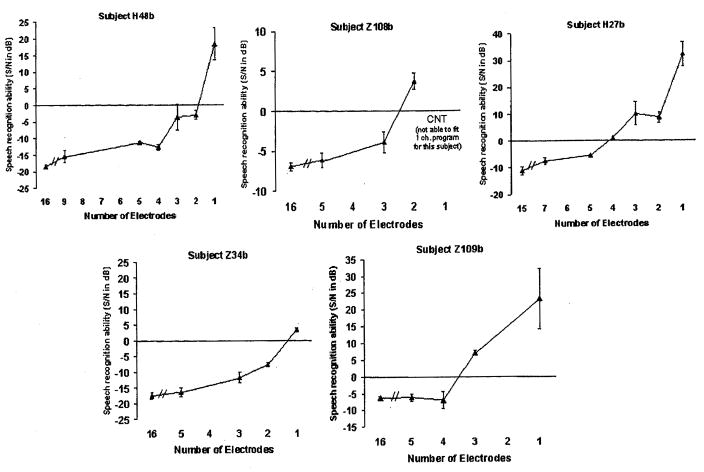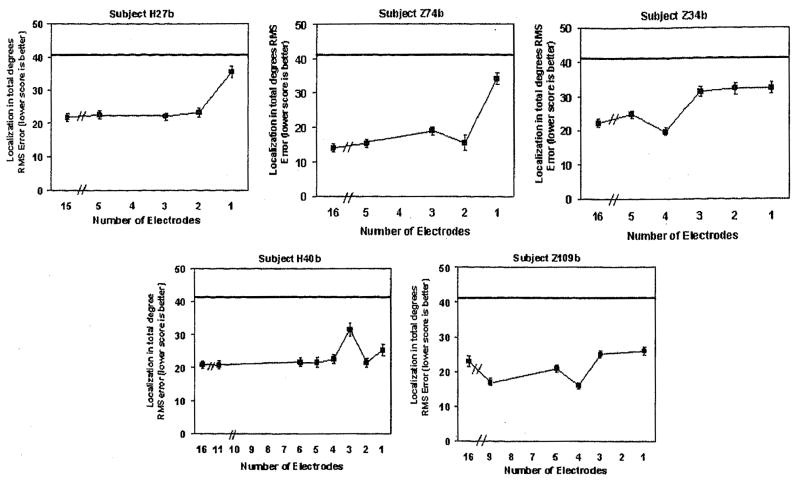Abstract
Background
Many studies have documented the effect of reducing spectral information for speech perception in listeners with normal hearing and hearing impairment. While it is understood that more spectral bands are needed for unilateral cochlear implant listeners to perform well on more challenging listening tasks such as speech perception in noise, it is unclear how reducing the number of spectral bands or electrodes in cochlear implants influences the ability to localize sound or understand speech with spatially separate noise sources.
Purpose
The purpose of this study was to measure the effect of reducing the number of electrodes for patients with bilateral cochlear implants on spatial hearing tasks.
Research Design
Performance on spatial hearing tasks was examined as the number of bilateral electrodes in the speech processor was deactivated equally across ears and the full frequency spectrum was reallocated to a reduced number of active electrodes. Program parameters (i.e., pulse width, stimulation rate) were held constant among the programs and set identically between the right and left cochlear implants so that only the number of electrodes varied.
Study Sample
Nine subjects had used bilateral Nucleus or Advanced Bionics cochlear implants for at least 12 mo prior to beginning the study. Only those subjects with full insertion of the electrode arrays with all electrodes active in both ears were eligible to participate.
Data Collection and Analysis
Two test measures were utilized to evaluate the effect of reducing the number of electrodes, including a speech-perception-in-noise test with spatially separated sources and a sound source localization test.
Results
Reducing the number of electrodes had different effects across individuals. Three patterns emerged: (1) no effect on localization (two of nine subjects), (2) at least two to four bilateral electrodes were required for maximal performance (five of nine subjects), and (3) performance gradually decreased across conditions as electrode number was reduced (two of nine subjects). For the test of speech perception in spatially separated noise, performance was affected as the number of electrodes was reduced for all subjects. Two categories of performance were found: (1) at least three or four bilateral electrodes were needed for maximum performance (five of seven subjects) and (2) as the number of electrodes were reduced, performance gradually decreased across conditions (two of seven subjects).
Conclusion
Large individual differences exist in determining maximum performance using bilateral electrodes for localization and speech perception in noise. For some bilateral cochlear implant users, as few as three to four electrodes can be used to obtain maximal performance on localization and speech-in-noise tests. However, other listeners show a gradual decrement in performance on both tasks when the number of electrodes is reduced.
Keywords: Bilateral cochlear implants, electrode number, localization, speech recognition
A large focus of cochlear implant (CI) research has been on how to best code frequency information to give optimal performance for cochlear implant recipients. In the normal-hearing ear, frequency information is coded by maximal basilar membrane motion, described by the envelope of basilar membrane vibration. Each region on the basilar membrane corresponds to a certain range of frequencies, effectively creating bandpass filters to code a range of stimulus frequencies. The stimulus frequency information using place coding is maintained throughout the auditory system, as the signal is processed by the hair cells, auditory neurons, the cochlear nucleus, and the auditory cortex. Frequency information can also be determined by phase locking, in which an increase in firing rate of an auditory neuron occurs that is locked to the stimulus frequency and corresponds to the best frequency of that fiber, up to about 4000 to 5000 Hz.
Similarly, cochlear implants provide cues to distinguish stimulus frequency by phase locking and the place-coding principle. Studies of electrical stimulation have shown that the detection and discrimination of timing cues are accurately represented in CI devices and similar to the performance of listeners with normal hearing (Shannon, 1993). Despite this, it is likely that CI users are not able to make use of high-frequency phase-locking cues beyond 300 Hz. Cochlear implants also code frequency based on the place-coding principle. The CI accomplishes this by separating the incoming sound into several frequency bands or filters, and the output of these bands is directed to a finite number of electrodes situated in the ear from base to apex of the cochlea. The organization of these channels typically corresponds to the tonotopic arrangement in the normal cochlea, so that a low-frequency sound will be coded by a low-frequency channel and then directed to an electrode in the apex of the cochlea and a high-frequency sound will be coded by a channel encoding high frequencies and presented to an electrode in the base of the cochlea. It is important to note that for CIs, the concepts of frequency channels and electrodes are not necessarily the same. The frequency channels in CI processors “map” the incoming signal onto the electrodes in the cochlea, which can be altered when programming CIs. Typically the frequency channels correspond directly to the placement of electrodes in the ear, but this is not always the case. The channels in a CI have a narrow range of frequency response corresponding to roughly 200 to 8000 Hz compared to the normal-hearing ear, with a range of 50 to 15,000 Hz (Moore, 2003). The number of channels is limited by the number of electrodes in the cochlea, which is typically restricted to approximately 8 to 20 depending on the internal device. However, the number of electrodes may be less depending on numerous factors related to the function of the CI, including interaction of electrical current in the ear, “dead regions” or the absence of neuronal survival, or the occurrence of open or short electrodes in the cochlea. Research has often questioned how many electrodes are needed by CI recipients to achieve superior speech-perception scores.
Many studies have examined the effects of reducing spectral resolution on speech-perception performance. An early study by Hill and colleagues (1968) found that increasing spectral bands from three to eight resulted in increasingly better performance on vowel-and consonant-recognition tasks for listeners with normal hearing. A recognition rate of 70% was achieved with six to eight frequency bands of information. Furthermore, Turner and colleagues (1995) reported an increase in syllable recognition for listeners with normal hearing when a minimal degree of frequency information was presented. In their study, the stimulus consisted of “signal correlated noise,” in which the speech waveform envelope was modulated by a flat-spectrum noise carrier. Performance increased from 25 to 40% when the stimulus included two frequency bands of correlated noise over just one band. Similarly, Shannon and colleagues (1995) studied the effect of reducing frequency resolution on consonant, vowel, and sentence recognition for listeners with normal hearing. By extracting the amplitude envelope from broad frequency bands and then using this to modulate white noise, stimuli were created from noise bands of one, two, three, and four channels and then presented to the subjects through headphones. Results from Shannon and colleagues (1995) showed that performance for vowels, consonants, and sentences increased as the number of noise bands increased from one to four. Additionally, performance reached 80% or higher with as few as three bands of noise for all speech-perception measures tested.
Research also indicates that more spectral bands might be necessary to understand speech in noise compared to speech in quiet. In a study by Friesen and colleagues (2001), five subjects with normal hearing were recruited, and performance on consonant, vowel, word, and sentence materials presented with speech-shaped masking noise at multiple signal-to-noise ratios (+15, + 10, +5, 0 dB S/N) was evaluated as the number of frequency bands was reduced. Performance continued to improve for all subjects as the number of bands increased up to 20 for all speech-perception tests. A meta-analysis by Shannon and colleagues (2004) also found that more spectral bands are necessary for listeners to perform well in more difficult listening situations. Shannon and colleagues report that simple tasks such as speech in quiet require only a few spectral bands (i.e., four—six) and more challenging tasks such as speech in noise and music listening require many more channels (i.e., 7–30). Although the above studies provide evidence of a relationship between speech perception in quiet and in noise and the number of spectral bands, most of these results are based on simulations using normal-hearing subjects. It is possible that the findings from simulations may not generalize to actual CI users.
In fact, studies of cochlear implant recipients have shown that as number of electrodes is increased, speech perception improves and then plateaus at about eight to 10 electrodes (Dorman et al, 1989; Lawson et al, 1996; Eddington et al, 1997; Fishman et al, 1997; Riss et al, 2008). Fishman and colleagues (1997) reported significant increases on consonant, vowel, word, and sentence tests in quiet for 11 subjects using the Nucleus-22 SPEAK processing strategy as the number of electrodes was increased from one to four. However, no difference in performance was noted on any of the test materials as the number of electrodes was increased from 4 to 7, 10, or 20. Furthermore, Friesen and colleagues (2001) compared performance for unilateral Nucleus-22 and Advanced Bionics Clarion CI users on consonants, vowels, words, and sentences in quiet and at various S/N (+15, +10, +5, 0 dB). Similar to Fishman and colleagues (1997), they also report improved speech perception as the number of electrodes was increased (up to seven or eight electrodes). As the number of electrodes was increased beyond eight, performance on all speech tests remained fairly constant. A more recent study by Riss and colleagues (2008) studied the number of active electrodes required for speech perception when using two signal-processing strategies, continuous interleaved sampling (CIS) and fine structure processing. They conclude that speech-perception performance improved as the number of electrodes increased and that simple tasks such as listening to numbers required only about four electrodes and more difficult listening tasks such as sentences required about eight electrodes. Finally, Dorman and colleagues (2000) evaluated word-recognition performance for 56 children with the Nucleus-22 cochlear implant as the number of electrodes was increased from 4 to 20. Results showed that 8 to 12 electrodes were required for accurate word understanding.
Based on studies of CI users (Lawson et al, 1996; Fishman et al, 1997; Dorman et al, 2000; Friesen et al, 2001; Riss et al, 2008), it appears that speech-perception performance increases with up to approximately seven to eight electrodes, but increasing beyond 8 to 12 electrodes results in relatively little improvement. Results differ slightly across these studies and likely can be attributed to several factors including the speech-recognition tests being used (i.e., words vs. sentences), differences in the amount of listening time with the electrode conditions prior to testing, differences in subjects’ ages (children or adult subjects), and differences attributed to intersubject variability. It is also important to note that different CI systems and signal-processing strategies do not appear to have an effect on speech perception as the numbers of electrodes are reduced. Specifically, Friesen and colleagues (2001) found no significant difference in performance for 19 subjects on vowel-, consonant-, word-, or sentence-perception tests in quiet and in noise when Nucleus-22 and Clarion implants were compared and when different signal-processing strategies such as SPEAK, CIS, and simultaneous analog stimulation (SAS) were used.
To date, most studies have reported group results when investigating the relationship between the number of electrodes and speech recognition for cochlear implant users. Previous studies have indicated that the number of electrodes for optimal performance depends on the individual listener or subject (Fishman et al, 1997; Frijns et al, 2003). Nerve survival may be a potential factor, in that the amount and location of viable nerve survival vary between subjects (Nadol et al, 1989). Fishman and colleagues (1997) reported that some CI users demonstrated increased performance when utilizing seven or more electrodes on speech-recognition tests. In contrast, other subjects obtained maximum performance with four to seven electrodes and showed a decrease in performance as more electrodes were added. Frijns and colleagues (2003) compared performance for nine subjects using a high-rate and low-rate CIS strategy with 8, 12, and 16 active electrodes and found that no one strategy or electrode condition benefited all listeners. Frijns and colleagues conclude that the optimal number of electrodes depended on the listener. Therefore, it is equally important to examine individual performance differences as well as any group trends when investigating the number of electrodes and speech recognition for CI users.
Previous studies indicate that a relationship exists between the number of electrodes and performance on speech-recognition tasks. Despite evidence in support of this notion, minimal research has investigated the effect of reducing the number of electrodes on sound source localization and speech recognition with spatially separate noise sources. In fact, the relationship between localization and speech hearing (i.e., speech recognition in noise) is unclear. Noble, Byrne, and Ter-Horst (1997) examined this relationship for listeners with sensorineural and conductive hearing loss on three psychoacoustic tests of localization, speech hearing, and detection of spatial separateness. The authors reported links between spatial separateness and benefit from separation of speech and noise, localization and separateness detection, and localization and speech hearing in nonspatially separated noise based on correlations among the three psychoacoustic test results. In comparison, Dunn and colleagues (2005) studied speech perception and localization performance for 12 listeners with a hearing aid plus a cochlear implant in opposite ears and found that two subjects with similar speech-recognition scores had drastically different localization scores (one subject had the second-best localization performance, and the other subject had the worst localization performance of all 12 subjects tested). Dunn and colleagues conclude that the relationship between localization and speech perception was apparent for some subjects but not for others. A focus of the current study is to further investigate the relationship between localization and speech perception in noise.
Previous studies examined speech-perception performance of listeners with a single cochlear implant as the number of CI electrodes was effectively reduced. In comparison, the present study will investigate this effect for listeners with bilateral cochlear implants by systematically reducing the same electrode number and position of electrodes across ears. It is possible that the effect of reducing the number of electrodes on localization and speech perception may be different for bilateral CI users compared to unilateral CI users. Research suggests that bilateral cochlear implantation provides numerous benefits to the listener including, but not limited to, improvements in tracking a moving sound source and better segregation of sound sources in noisy situations (Au et al, 2003; Kong et al, 2003; Ricketts et al, 2006; Tyler et al, 2006a) and improvements in speech understanding in noise due to the ability to select the ear with the better signal-to-noise ratio (Gantz et al, 2002; van Hoesel et al, 2002; Moore, 2003; Litovsky et al, 2006; Ching et al, 2007). These potential advantages are likely influenced by the availability of input to two ears. It is possible that the advantages of having two ears may impact overall performance when the number of electrodes is reduced in cochlear implants and, therefore, may produce different results than previously shown for unilateral CI users.
The purpose of the present study was to evaluate speech-perception performance and sound source localization abilities for bilateral cochlear implant recipients as the number of cochlear implant electrodes was reduced equally across ears.
METHOD
Subjects
Nine bilateral CI users, ages 35–71 (average age = 57.7yr), served as subjects in this study. Table 1 displays the subject demographics for each participant. Seven women and two men participated in this study, and all subjects were native American English speakers. Subjects were implanted with either the Nucleus or Advanced Bionics cochlear implants, bilaterally, and had used their devices for at least 12 mo prior to beginning the study. Only those subjects with full insertion of the electrode arrays with all electrodes active in both ears were eligible to participate.
Table 1.
Subject Demographic Information
| Subject ID | Age (yr) | Implant Type | Duration of CI Use (yr, mo) | Age at Onset of HL (yr, mo) |
Age at Onset of Profound HL (yr, mo) |
Speech Processing Strategy | Pulse Width (μsec) | ||
|---|---|---|---|---|---|---|---|---|---|
| R | L | R | L | ||||||
| M58b | 68 | Nucleus CI-24 M | 8, 11 | 42 | 25 | 57 | 58 | ACE | 25 |
| Z74b | 71 | ABC Hires 90k | 1, 11 | 55, 6 | 55, 6 | 61 | 61 | HiRes-S | 30.5 |
| Z109b | 61 | ABC Hires 90k | 1, 0 | 30 | 30 | 58 | 58 | HiRes-S | 12.6 |
| H40b | 46 | Clarion HiFocus II | 4, 11 | 21 | 21 | 31 | 31 | HiRes-S | 21.6 |
| H48b | 48 | Clarion HiFocus II | 5, 4 | 34 | 34 | 42 | 42 | HiRes-S | 15.3 |
| H27b | 67 | Clarion HiFocus II | 6, 5 | 45 | 45 | 55 | 55 | HiRes-S | 10.8 |
| Z108b | 59 | ABC HiRes 90k | 1, 0 | 33 | 33 | 56, 6 | 56 | HiRes-S | 13.5 |
| Z63b | 64 | ABC HiRes 90k | 2, 0 | 28 | 28 | 57 | 57 | HiRes-S | 37.7 |
| Z34b | 35 | ABC HiRes 90k | 3, 11 | 3 | 3 | 18 | 18 | HiRes-S | 10.8 to 12.6 |
Note: Two different pulse widths were utilized in the programming for subject Z34b. ACE = Advanced Combination Encoder; HiRes-S = HiResolution sequential.
Test Conditions
The test conditions for this study were created with different numbers of active electrodes, and performance was compared across conditions. Electrodes were turned off in the programs, and the full speech spectrum was preserved by reallocating the frequency channels or bands to the active electrodes. When electrodes were deactivated, the active electrodes were evenly spaced apart from one another, so that the frequencies were evenly distributed spatially in the cochlea. For example, a nine-channel program was created by evenly spacing the nine active electrodes in the following manner: 16, 14, 13, 11, 8, 6, 4, 3, and 1. The testing conditions included programs with the following number of electrodes activated: 20, 16, 15, 11, 10, 9, 8, 7, 6, 5, 4, 3, 2, and 1. The number of programmable electrodes varied between subjects based on their performance on each test and each condition. However, the same electrodes were activated or deactivated equally across ears for each subject.
Clinical speech processors and cochlear implant programming software were used to create the test conditions. Commercial speech processor strategies, including the Advanced Combination Encoder and HiResolution-sequential strategies, were used for testing. All parameters (i.e., input dynamic range, microphone settings, compression) were kept consistent throughout the test conditions. Additionally, program parameters for the right and left cochlear implants were set identically between the ears. Because the overall stimulation rate for the devices from Advanced Bionics Corporation depends on the number of electrodes activated in each program, the pulse width parameter was held constant and the stimulation rate varied among programs. Likewise, for the Nucleus devices, the stimulation rate and pulse width were held constant, and the maxima varied among the programs. Listed in the rightmost columns in Table 1 are the parameters for processing strategy and pulse width. For each program, electrical comfort levels were measured on each electrode, and electrical threshold levels were either set at a default level or measured when needed. The programs were activated in live voice mode, and volume adjustments were made to equalize loudness between the right and left CIs. The programs were loaded into the speech processors, and subjects were kept blind to the programs that were loaded into their processor. Prior to testing each condition, subjects were given a brief period of listening (approximately 10 min) to get accustomed to the individual programs.
Test Measures
Two tests were utilized in this study to compare performance across conditions. The first test was an Everyday Sounds Localization test that was administered to assess each subject’s ability to localize sound in the horizontal plane. Sixteen everyday sounds (i.e., glass breaking, a knock at the door, child laughing, etc.) were presented through eight loudspeakers, each 15.5 degrees apart, spanning a 108 degree arc in front of the subject (Dunn et al, 2005). The stimuli were each presented six times randomly from one of the eight speakers at 70 dB[C]. Subjects could see all eight loudspeakers placed in the horizontal arc in front of them. No feedback was provided throughout the test. A total of 96 trials were included in each test. The subjects were instructed to face forward and restrict head movement during the duration of the test. Each subject selected the speaker number from which the sound originated using a touch screen monitor placed in front of him or her. Scores were reported by the average total root mean square (RMS) error, taking into account variability and standard error in the responses by the subjects. Chance performance is approximately 40 degrees RMS error, and lower scores on this test (i.e., RMS error of 10 to 20 degrees) represented better localization abilities. Before the onset of the localization test, a practice session, which involved presenting one of the everyday sounds from the eight loudspeakers, was initiated to familiarize the subjects to this task.
Additionally, an adaptive 12-choice spondee word in babble test, which we refer to as the Cued SRT, or localization and recognition test, was administered (Tyler et al, 2006b). Stimuli were presented through an eight-loudspeaker testing array (as described above with the localization test), with the target word originating from one loudspeaker and the babble presented from a spatially separate loudspeaker. The babble consisted of a two-talker (one female and one male) voice repeating different sentences. An auditory cue (“hey, I’m over here”) was presented prior to the onset of the spondee word to indicate to the subject from which loudspeaker the target word would be heard. In this test, the subject’s task was to listen for the target spondee word (see Turner et al, 2004). This test incorporated five runs total, with multiple trials per run. Scores were represented by the signal-to-noise ratio required to accurately recognize 50% of the spondee words. The first two runs in each test were practice runs, and the last three out of five runs were averaged to produce a signal-to-noise ratio score for the test. Two subjects (H40b, Z63b) could not be included in the Cued SRT test due to time constraints while testing.
The data were analyzed by comparing total RMS error among the test conditions on the localization test and by comparing the signal-to-noise ratio for the Cued SRT test.
RESULTS
Results for the eight-loudspeaker localization test and Cued SRT test are graphed in Figures 1 through 7. Figures 1 and 5 show group results with all active electrodes in the cochlear implant program compared to performance with a reduced number of bilateral electrodes. For Figures 2–4 and 6–7, results are shown for each subject individually. In these figures, the channel conditions are listed on the x-axis, and performance is charted on the y-axis either by total RMS error in degrees (for the Everyday Sounds Localization test) or signal-to-noise ratio in dB (for the Cued SRT test).
Figure 1.
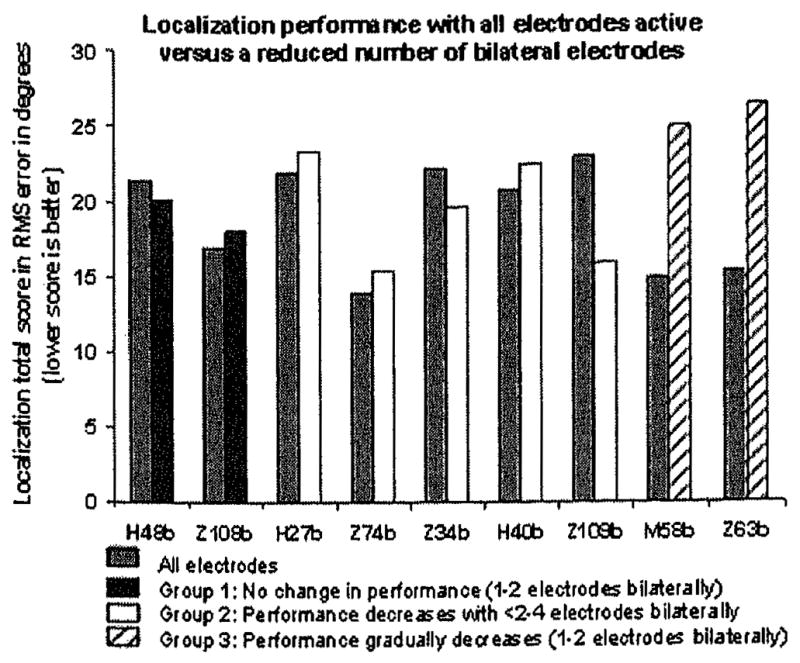
Performance on the Everyday Sounds Localization test in quiet with all electrodes active bilaterally versus a reduced number of bilateral electrodes for all nine subjects. The subjects are listed on the x-axis and coded to indicate their performance with a reduced number of electrodes. Localization scores are reported in RMS error on the y-axis. Lower scores indicate better localization ability.
Figure 7.
Results from the Cued SRT test for subjects M58b and Z74b. S/N score and the standard deviation are reported for each condition. Negative scores indicate better speech-recognition ability.
Figure 5.
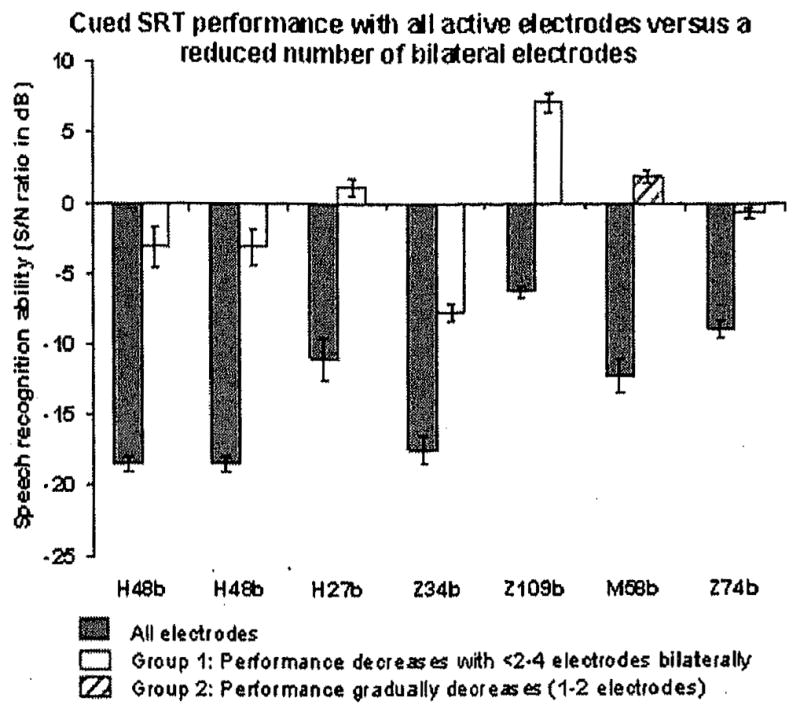
Performance on the Cued SRT test with all electrodes active bilaterally versus a reduced number of bilateral electrodes for seven subjects. The subjects are listed on the x-axis and coded to indicate their performance with a reduced number of electrodes. S/N score and the standard deviation are reported for each condition. Negative scores indicate better speech-recognition ability.
Figure 2.
Performance as a function of reducing electrode number for the Everyday Sounds Localization test in quiet for subjects H48b and Z108b. Scores are reported in RMS error, and lower scores indicate better localization ability. Chance performance is marked by a thick line at approximately 40 degrees RMS error.
Figure 4.
Results from Everyday Sounds Localization for subjects M58b and Z63b. Scores are reported in RMS error, and lower scores indicate better localization ability. Chance performance is marked by a thick line at approximately 40 degrees RMS error.
Figure 6.
Performance on the Cued SRT test as a function of reducing electrode number for subjects H48b, Z108b, H27b, Z34b, and Z109b. S/N score and the standard deviation are reported for each condition. Negative scores indicate better speech-recognition ability.
Figure 1 shows results from the Everyday Sounds Localization test for the nine subjects with all active electrodes bilaterally versus a reduced number of bilateral electrodes. Average performance across subjects when all channels were active in their cochlear implant program was equal to an 18.6 degree RMS error, with a range from 14.0 to 23.0 degrees RMS error. Overall results revealed that reducing the number of electrodes had an effect on sound localization performance for all subjects except two (H48b and Z108b, shown in the black bars). Results in Figure 1 are graphed in a sequential order along the x-axis relative to the effect of reducing electrode number. Three specific patterns of performance emerged: (1) no difference in performance (group 1, shown in black), (2) performance worsened when fewer than two to four bilateral electrodes were active (group 2, shown in white), and (3) performance gradually decreased across conditions as electrode number was reduced (group 3, shown in diagonal pattern). Localization results for each subject across all electrode conditions are presented in Figures 2–4. Figure 2 shows that subjects H48b and Z108b demonstrated no difference in performance as the number of electrodes was reduced from 16 to one or two electrodes. For subject Z108b, the one-electrode condition could not be tested as no electrical comfort level could be obtained during programming with only one channel. Figure 3 shows results for subjects H27b, Z74b, Z34b, H40b, and Z109b, whose localization ability was not affected as the number of electrodes was reduced to either two or four electrodes bilaterally. However, for these subjects, a dramatic decrease in performance was observed when the number of electrodes was further reduced beyond two or four. Figure 4 shows results for subjects M58b and Z63b, who demonstrated gradual decrements in performance as the number of electrodes was reduced across electrode conditions.
Figure 3.
Results on the Everyday Sounds Localization test for subjects H27b, Z74b, Z34b, H40b, and Z109b. Scores are reported in RMS error, and lower scores indicate better localization ability. Chance performance is marked by a thick line at approximately 40 degrees RMS error.
For the Cued SRT test, data were collected on seven out of nine total subjects. Due to time constraints no data were collected for subjects H40b and Z63b. Figure 5 shows results from the Cued SRT test for all seven subjects with all active electrodes bilaterally versus a reduced number of bilateral electrodes. The average signal-to-noise ratio with all electrodes active in the cochlear implant program was −12.0 dB, with a range of −18.5 to −6.3 dB. Overall, results indicated that as the number of electrodes was reduced, performance on the Cued SRT test was affected and decreased for all subjects. Furthermore, two categories of performance were found: (1) at least three or four bilateral electrodes were needed for maximum performance (group 1, shown in white), and (2) as the number of electrodes was reduced, performance gradually decreased across conditions (group 2, shown in diagonal pattern). Individual results for subjects H48b, Z108b, H27b, Z34b, and Z109b are presented in Figure 6. For these subjects, performance was relatively unchanged as the number of electrodes was reduced to three to four bilateral electrodes. However, performance was greatly affected when the number of electrodes was further reduced to less than three to four electrodes and very poor when only one electrode was active bilaterally. Figure 7 shows results for subjects M58b and Z74b. Subject M58b showed a more gradual decrease in speech-perception performance as the number of electrodes was reduced. In addition, this subject was not able to complete the task with only one electrode active bilaterally. Subject Z74b was tested with only two conditions (1 vs. 16 electrodes) due to time constraints during testing. Despite this, results were consistent with the other subjects in this study, in that a decrease in performance was noted as the number of electrodes was reduced.
DISCUSSION
The present study describes the effect of reducing the number of electrodes on source localization and speech perception in spatially separated noise for bilateral CI users. On both tasks, results were highly dependent upon the individual, a finding that is consistent with previous reports by Fishman and colleagues (1997) and Frijns and colleagues (2003). For localization, results revealed that reducing the number of electrodes had an impact on performance for all but two subjects (H48b and Z108b). Interestingly, these two subjects did equally well with one electrode as they did with a maximum amount of electrodes, scoring well above chance performance. For the Cued SRT, reducing the number of electrodes had an impact on performance for all subjects. The results from this study indicate that it is possible to perform spatial hearing tasks with only one electrode active bilaterally. It should be noted, however, that except for subjects H48b and Z108b, scores obtained with only one electrode active bilaterally were generally near chance performance; nonetheless, scores were obtained. Previous research has also shown that spatial hearing tasks can be completed with only one electrode. A study by Dunn and colleagues (2004) investigated different frequency and electrode contributions for bilateral cochlear implant users and concluded that localization is possible with the stimulation of only one electrode. Studies of speech-perception abilities, on the other hand, indicate that one electrode is not sufficient for listeners to achieve maximum performance. A study by Tyler (1988) examined the speech-perception abilities of four subjects with a unilateral implant using a single electrode and found that one of the four subjects obtained scores of 80% and 63% correct on sentence and word tests, respectively. In most studies, however, very poor performance on speech-perception tasks has been documented with only one or two electrodes (Fishman et al, 1997; Friesen et al, 2001; Riss et al, 2008). Results from the present study found that more electrodes were required for listeners to perform well on the Cued SRT test compared to the localization test. Therefore, it seems possible that the binaural hearing mechanism is able to use less spectral information (or one electrode bilaterally) for determining location and directionality of sound but that speech recognition likely requires more electrodes to perform equally well.
The contrast between localization and speech-perception performance relative to the number of active electrodes was an additional aim for this study. Within-subject results on the localization test and Cued SRT test were compared. For most subjects, reducing electrode number had the same effect for both localization and speech-perception test measures, and performance decreased on both tests as the number of bilateral electrodes was reduced. The exception was subjects H48b and Z108b, where a difference emerged between speech perception and localization as the number of electrodes was reduced. These two subjects were able to localize effectively with many versus one electrode active bilaterally, but their speech-perception abilities decreased as the number of electrodes was reduced. In the Everyday Sounds Localization and Cued SRT tasks used in this study, stimuli were presented from various loudspeaker locations along the horizontal plane of the listener. Although the stimuli differed in these tasks (everyday sounds vs. speech), it seems possible that overall performance between the two tests would be affected similarly. By preserving the full speech spectrum bilaterally when using a reduced number of electrodes, the subjects were able to utilize binaural cues, such as loudness and spectral cues, to identify the stimuli location and to effectively separate the noise from the speech stimuli. However, this study, along with the results from Dunn and colleagues (2005), identified two subjects where performance on speech perception and localization was not related, suggesting that these tasks might be less related than expected. Therefore, it is probable that spatial hearing tasks of sound localization and speech perception in noise might be two fundamentally different processes and require more than one model to explain how these two relate to one another. Most models of spatial hearing relate to the coincident detector model (Jeffress, 1948) or that defined by the neuronal activity within a population of neurons (McAlpine et al, 2001) wherein stimulus frequency is coded by the coincidence in timing of the synapse from right to left auditory tracts. Furthermore, localization of sound might be accomplished by comparing other cues such as the onset and the intensity of the stimulus from right to left ears and requires less precise spectral representation of the sound. This differs greatly from what is required for speech perception, which relies upon accurate representation of fundamental frequency sampled over time.
The conclusions of this study can be summarized by the following:
Reducing the number of electrodes had an effect on localization for all but two subjects.
Reducing the number of electrodes had an effect on speech perception in spatially separated noise for all subjects.
Large individual differences exist in determining the minimum number of electrodes needed for maximum performance for both localization and speech perception. For some bilateral cochlear implant users, as few as three to four electrodes can be used to obtain maximal performance on either localization or speech in spatially separated noise. However, other listeners show a gradual decrement in performance on both tasks as the number of electrodes is reduced.
Reducing the number of electrodes has the same effect (reduces performance) for both localization and speech in spatially separated noise for most bilateral cochlear implant recipients. However, results from two subjects showed that as the number of electrodes was reduced, localization performance was unaffected while speech performance in spatially separated noise was affected.
Sound localization is possible with only one electrode active bilaterally. However, speech perception likely requires more electrodes for maximal performance.
Acknowledgments
This research was supported in part by research grant 5 P50 DC00242 from the National Institute on Deafness and Other Communication Disorders, National Institutes of Health; grant M01-RR-59 from the General Clinical Research Centers Program, Division of Research Resources, National Institutes of Health; the Lions Clubs International Foundation; and the Iowa Lions Foundation.
We would like to acknowledge the efforts of our research team, including Camille Dunn, Beth Macpherson, Monika Kordus, Smita Agrawal, Haihong Ji, and Son-A Chang.
Abbreviations
- CI
cochlear implant
- CIS
continuous interleaved strategy
- RMS
root mean square
- S/N
signal-to-noise ratio
References
- Au DK, Hui Y, Wei WI. Superiority of bilateral cochlear implantation over unilateral cochlear implantation in tone discrimination in Chinese patients. Am J Otolaryngol. 2003;24(1):19–23. doi: 10.1053/ajot.2003.8. [DOI] [PubMed] [Google Scholar]
- Ching TY, van Wanrooy E, Dillon H. Binaural-bimodal fitting or bilateral implantation for managing severe to profound deafness: a review. Trends Amplif. 2007;11(3):161–192. doi: 10.1177/1084713807304357. [DOI] [PMC free article] [PubMed] [Google Scholar]
- Dorman M, Dankowski K, McCandless G, Smith L. Consonant recognition as a function of the number of channels of stimulation by patients who use the Symbion cochlear implant. Ear Hear. 1989;10(5):288–291. doi: 10.1097/00003446-198910000-00003. [DOI] [PubMed] [Google Scholar]
- Dorman MF, Loizou PC, Kemp LL, Kirk KI. Word recognition by children listening to speech processed into a small number of channels: data from normal-hearing children and children with cochlear implants. Ear Hear. 2000;21(6):590–596. doi: 10.1097/00003446-200012000-00006. [DOI] [PubMed] [Google Scholar]
- Dunn C, Tyler RS, Witt SA, Gantz BJ, Rubinstein J. Frequency and electrode contributions to localization in bilateral cochlear implants. Int Congr Ser. 2004;1273:443–446. [Google Scholar]
- Dunn CC, Tyler RS, Witt SA. Benefit of wearing a hearing aid on the unimplanted ear in adult users of a cochlear implant. J Speech Lang Hear Res. 2005;48(3):668–680. doi: 10.1044/1092-4388(2005/046). [DOI] [PubMed] [Google Scholar]
- Eddington D, Rabinowitz WM, Tierney J, Noel V, Whearty M. Speech Processors for Auditory Prostheses. No. 8th Quarterly Progress Report, NIH Contract N01-DC-6-2100.1997. [Google Scholar]
- Fishman KE, Shannon RV, Slattery WH. Speech recognition as a function of the number of electrodes used in the SPEAK cochlear implant speech processor. J Speech Lang Hear Res. 1997;40(5):1201–1215. doi: 10.1044/jslhr.4005.1201. [DOI] [PubMed] [Google Scholar]
- Friesen LM, Shannon RV, Baskent D, Wang X. Speech recognition in noise as a function of the number of spectral channels: comparison of acoustic hearing and cochlear implants. J Acoust Soc Am. 2001;110(2):1150–1163. doi: 10.1121/1.1381538. [DOI] [PubMed] [Google Scholar]
- Frijns JHM, Klop WM, Bonnet RM, Briaire JJ, Briaire J. Optimizing the number of electrodes with high-rate stimulation of the clarion CII cochlear implant. Acta Otolaryngol. 2003;123(2):138–142. doi: 10.1080/0036554021000028126. [DOI] [PubMed] [Google Scholar]
- Gantz BJ, Tyler RS, Rubinstein JT, et al. Binaural cochlear implants placed during the same operation. Otol Neurotol. 2002;23(2):169–180. doi: 10.1097/00129492-200203000-00012. [DOI] [PubMed] [Google Scholar]
- Hill PJ, McRae LP, McClellan RP. Speech recognition as a function of channel capacity in a discrete set of channels. J Acoust Soc Am. 1968;44(1):13–18. doi: 10.1121/1.1911047. [DOI] [PubMed] [Google Scholar]
- Jeffress LA. A place theory of sound localization. J Comp Physiol Psychol. 1948;41(1):35–39. doi: 10.1037/h0061495. [DOI] [PubMed] [Google Scholar]
- Kong W, Yu L, Xu Y, et al. Benefit of bilateral cochlear implantation on congenital prelingually deafened Chinese-speaking children. [In Chinese] Lin Chuang Er Bi Yan Hou Ke Za Zhi. 2003;17(10):577–579. [PubMed] [Google Scholar]
- Lawson D, Wilson BS, Zerbi M, Finley CC. Speech Processors of Auditory Prostheses. Third Quarterly Progress Report, NIH Contract N01-DC-5-2103..1996. [Google Scholar]
- Litovsky R, Parkinson A, Arcaroli J, Sammeth C. Simultaneous bilateral cochlear implantation in adults: a multicenter clinical study. Ear Hear. 2006;27(6):714–731. doi: 10.1097/01.aud.0000246816.50820.42. [DOI] [PMC free article] [PubMed] [Google Scholar]
- McAlpine D, Jiang D, Palmer AR. A neural code for low-frequency sound localization in mammals. Nat Neurosci. 2001;4(4):396–401. doi: 10.1038/86049. [DOI] [PubMed] [Google Scholar]
- Moore BCJ. Coding of sounds in the auditory system and its relevance to signal processing and coding in cochlear implants. Otol Neurotol. 2003;24(2):243–254. doi: 10.1097/00129492-200303000-00019. [DOI] [PubMed] [Google Scholar]
- Nadol JB, Jr, Young YS, Glynn RJ. Survival of spiral ganglion cells in profound sensorineural hearing loss: implications for cochlear implantation. Ann Otol Rhinol Laryngol. 1989;98(6):411–416. doi: 10.1177/000348948909800602. [DOI] [PubMed] [Google Scholar]
- Noble W, Byrne D, Ter-Horst K. Auditory localization, detection of spatial separateness, and speech hearing in noise by hearing impaired listeners. J Acoust Soc Am. 1997;102(4):2343–2352. doi: 10.1121/1.419618. [DOI] [PubMed] [Google Scholar]
- Ricketts TA, Grantham DW, Ashmead DH, Haynes DS, Labadie RF. Speech recognition for unilateral and bilateral cochlear implant modes in the presence of uncorrelated noise sources. Ear Hear. 2006;27(6):763–773. doi: 10.1097/01.aud.0000240814.27151.b9. [DOI] [PubMed] [Google Scholar]
- Riss D, Arnoldner C, Baumgartner WD, Kaider A, Hamzavi JS. A new fine structure speech coding strategy: speech perception at a reduced number of channels. Otol Neurotol. 2008;29(6):784–788. doi: 10.1097/MAO.0b013e31817fe00f. [DOI] [PubMed] [Google Scholar]
- Shannon RV, Fu Q, Galvin J. The number of spectral channels required for speech recognition depends on the difficulty of the listening situation. Acta Otolaryngol. 2004;552(Suppl):50–54. doi: 10.1080/03655230410017562. [DOI] [PubMed] [Google Scholar]
- Shannon RV, Zeng FG, Kamath V, Wygonski J, Ekelid M. Speech recognition with primarily temporal cues. Science. 1995;270 (5234):303–304. doi: 10.1126/science.270.5234.303. [DOI] [PubMed] [Google Scholar]
- Shannon RV. Psychophysics. In: Tyler RS, editor. Cochlear Implants: Audiological Foundations. San Diego: Singular Publishing Group, Inc; 1993. pp. 357–388. [Google Scholar]
- Turner CW, Souza PE, Forget LN. Use of temporal envelope cues in speech recognition by normal and hearing-impaired listeners. J Acoust Soc Am. 1995;97(4):2568–2576. doi: 10.1121/1.411911. [DOI] [PubMed] [Google Scholar]
- Turner CW, Gantz BJ, Vidal C, Behrens A, Henry BA. Speech recognition in noise for cochlear implant listeners: benefits of residual acoustic hearing. J Acoust Soc Am. 2004;115(4):1729–1735. doi: 10.1121/1.1687425. [DOI] [PubMed] [Google Scholar]
- Tyler RS. Open-set word recognition with the Duren/Cologne extracochlear implant. Laryngoscope. 1988;98(9):999–1002. doi: 10.1288/00005537-198809000-00015. [DOI] [PubMed] [Google Scholar]
- Tyler RS, Dunn CC, Witt SA, et al. Soundfield hearing for patients with cochlear implants and hearing aids. In: Cooper HR, Craddock LC, editors. Cochlear Implants, a Practical Guide. London: Whur Publishers; 2006a. pp. 338–365. [Google Scholar]
- Tyler RS, Noble W, Dunn C, Witt S. Some benefits and limitations of binaural cochlear implants and our ability to measure them. Int J Audiol. 2006b;45(Suppl 1):113–119. doi: 10.1080/14992020600783095. [DOI] [PubMed] [Google Scholar]
- van Hoesel R, Ramsden R, Odriscoll M. Sound-direction identification, interaural time delay discrimination, and speech intelligibility advantages in noise for a bilateral cochlear implant user. Ear Hear. 2002;23(2):137–149. doi: 10.1097/00003446-200204000-00006. [DOI] [PubMed] [Google Scholar]



